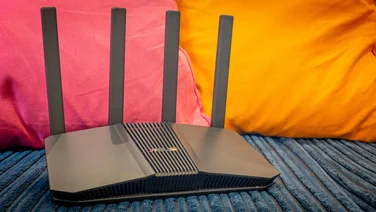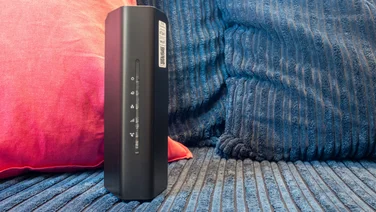To help us provide you with free impartial advice, we may earn a commission if you buy through links on our site. Learn more



- Amazingly cheap
- Brilliantly easy to set up
- Neat and unobtrusive
- Relatively slow speeds
- Limited coverage
- No access point mode
Mesh networking kits aren’t cheap; that’s the received wisdom, anyway. But Tenda’s new Nova MW3 system turns that on its head with an ultra-low price of just £92. For less than the cost of a regular mid-range router, you get a full set of three Wi-Fi nodes, ready to distribute wireless connectivity to the far reaches of your home. At such a low price, can it possibly be any good?
READ NEXT: The best wireless routers you can buy
Tenda Nova MW3 review: What you need to know
The Nova MW3 is a mesh system in the same vein as Google Wifi, the Linksys Velop and numerous other kits. It consists of three nodes (there’s also a two-node option for £70) which you position in various rooms around your home. They communicate wirelessly with each other, and each one acts as a Wi-Fi access point to deliver a good signal to places where a single router wouldn’t reach.
Like most mesh systems, the Nova MW3 system is designed to replace your existing router, but it doesn’t contain its own modem. The idea is that you connect your existing broadband modem to one of the nodes with an Ethernet cable; if your modem is built into your router, you can leave it in place and use the Nova MW3 nodes as wireless extenders.
Tenda Nova MW3 review: Price and competition
The Tenda Nova MW3 really has no competition at this price point. Our top-value alternative would be the BT Whole Home Wi-Fi kit, which delivers great coverage and connection speeds – but at £200 for three nodes it’s more than twice as expensive.
Tenda Nova MW3 review: Setting up
The MW3 units are inconspicuous white cubes, with bumpy tops to add a hint of visual interest. They’re small too, measuring just 90mm on each side, so they won’t dominate a shelf or worktop.
Getting set up is astonishingly easy. Once you’ve powered up your first node, and hooked it up to your modem, the Tenda smartphone app automatically sets up your internet connection and invites you to specify a name and password for your new wireless network.
Then it’s a simple matter of carting the other two nodes into different rooms, plugging each one in and waiting a few minutes while they boot up and receive their settings from the primary unit. A coloured LED on each unit will warn you if it’s too far away from its brethren to get a good signal.
There’s nothing more to configure unless you want to apply custom network settings. You can optionally enable an isolated guest network, configure port forwarding and set up simple parental controls, which let you block internet access for specific clients during defined times.
A few key features are conspicuously missing, though. For one, you can’t bind IP addresses to specific devices, which might annoy those who want to precisely replicate their old network. There’s also no proper access point mode. If you connect the Tenda system to your existing router, it’ll operate as a separate subnet, which means some clients might not be able to communicate with each other. Hopefully, that’ll be resolved in a future firmware update.



As well as 802.11ac wireless, each node offers two Ethernet connectors. That’s par for the course for compact mesh systems, but it always feels rather constraining – especially since one port on the primary node is taken up by the connection to your broadband modem.
Tenda Nova MW3 review: Performance
For several reasons, I wasn’t expecting the Nova MW3 to deliver exceptional performance. For one, its 5GHz radios claim a fairly modest maximum data rate of 867Mbits/sec, which is half the speed of the units in the BT Whole Home Wi-Fi system.
What’s more, since there’s only one radio per unit, your devices have to share that bandwidth with “backhaul” traffic as it’s forwarded from node to node. The small size of the nodes meanwhile limits the size and, therefore, the range of the internal antennae: the three-node Tenda kit promises coverage up to 300m2, while the BT system offers a much more generous 420m2.



In use, though, I found the Tenda MW3 delivered a solid, if not exactly speedy, connection. Having distributed the units along the length of my home, I was able to download files from my NAS drive to an 802.11ac-enabled laptop at average rates of 9MB/sec in the living room, 8MB/sec in the bedroom, and 7MB/sec in the bathroom. That’s much better coverage than I’d been getting from my old standalone router: before installing the system, the signal in the bedroom had been iffy, and I’d been unable to get a connection at all in the bathroom.
These speeds, however, are low by mesh standards. The BT Whole Home Wi-Fi system was more than twice as fast in the living room and never slower than 12MB/sec anywhere in my home. Frankly, the discrepancy was larger than I’d expected.
A skim of the Tenda’s technical specifications revealed the explanation. Alongside lightweight Wi-Fi hardware, the MW3 nodes also use 100Mbits/sec Ethernet ports, rather than the Gigabit type we’re accustomed to. That puts a hard speed limit of around 10MB/sec on all wired resources – including your NAS drive and your internet connection.
This doesn’t have to be a deal-breaker, though. The system was still nippy enough to give me the full speed of a 50Mbits/sec (around 6MB/sec) fibre connection all through my home.
Tenda Nova MW3 review: Verdict
If you’re looking for superfast downloads or if you regularly access big files from a home NAS drive, then the Tenda Nova MW3 clearly isn’t the right product for you. Its slow Ethernet ports act as a bottleneck, so you can’t enjoy the full speed of a high-end internet connection or network storage device.
That doesn’t necessarily mean it’s a write-off, though. The MW3 system completely cleared up the notspots in my home, with practically zero configuration required on my part. And the connection was still perfectly fast enough to browse the web, ping sensibly sized files back and forth over my home network and even stream 4K video.
In short, even, although it won’t handle the highest data rates or fill the largest homes, the Tenda Nova MW3 is a great option for apartment-dwellers who prioritise simplicity and ease of use. At this price, I suspect it will make a lot of people very happy.









